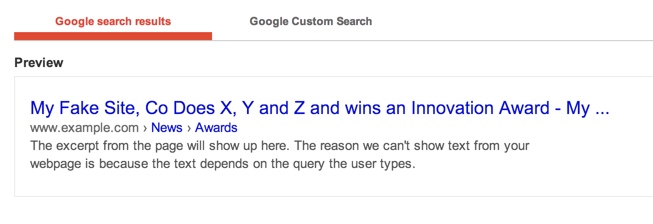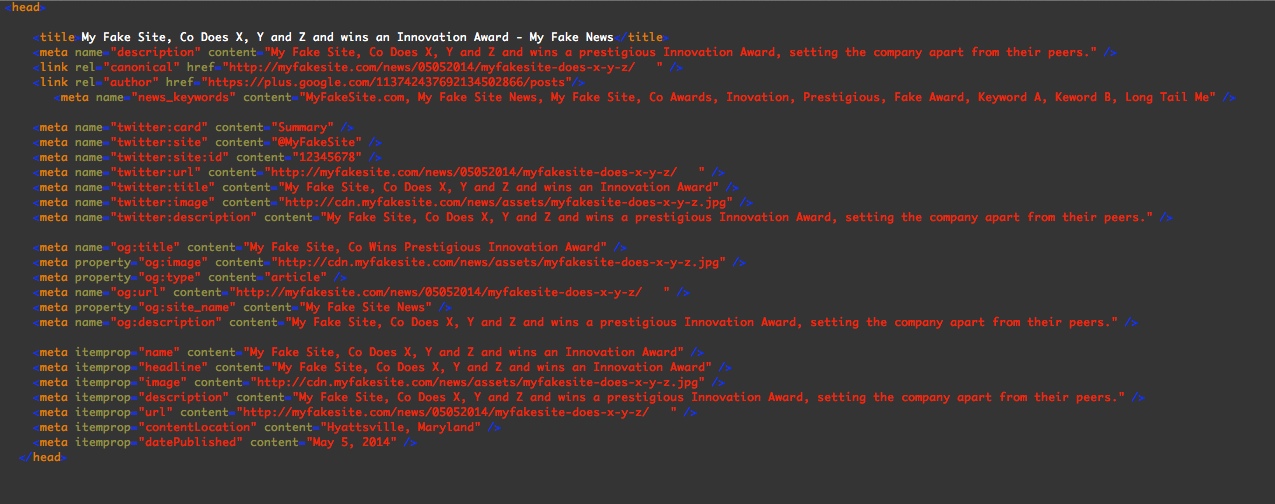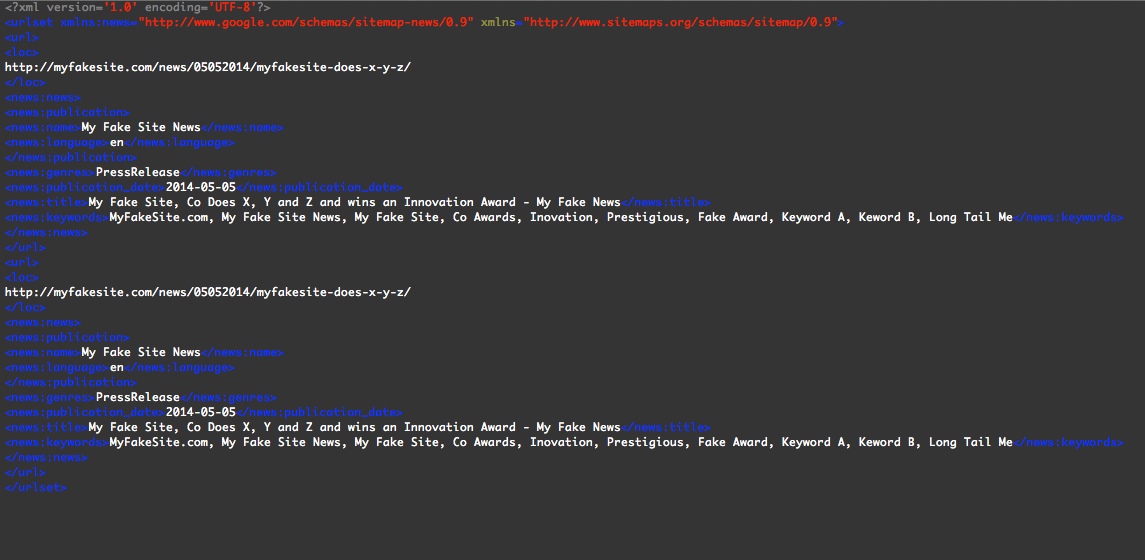I have a bit of experience with news center and news release SEO from a past life. Recently I was tasked with outlining the requirements for a client news center, and I found the following came pretty naturally.
Here is a brief and hypothetical outline of best practices and recommendations for the ‘MyFakeSite.com’ news center including news release page Meta, Social Meta, URL structure and xml news sitemap.
We also later applied these tactics to a large news website and you can read the results in this case study.
URL Structure:
News releases should only be accessible from static, clean and user friendly URLs in a “news” directory, like ‘myfakesite.com/news/date/postname/’. Due to the release title length, it is recommended to keep the releases as close to root as possible, removing any extraneous directories from the URL structure.
- Recommended structure options:
- http://myfakesite.com/news/05052014/myfakesite-does-x-y-z/
- 8 digit directory for date, offering unique number string for Google News (requires at least 3 digits)
- CMS should remove any “stop words” in URL
- http://myfakesite.com/news/2014/0505/myfakesite-does-x-y-z/
- Date displayed using year-by-year directories and a combined directory for the month and day.
- Implement if the PR team at MyFakeSite.com prefers yearly archives, not attainable w/ tags or categories from the CMS.
Taxonomy and Indexation Settings
Categories and tags (native to CMS) can be used to further segment and sort news for site visitors as well as for creating feeds to display content on other pages on MyFakeSite.com or externally. Tags can be used on the release pages to find additional news for any given topic, service, location or business division. All tags and categories should be pre-defined values, not free form areas for content editors to create new or alter in any way.
- Categories:
- Use for larger content grouping like Business Division or Services
- Tags:
- Use for smaller, though structured content grouping like location and content topics (“Awards”, “Company News”)
- URL Structure:
- Categories and Tags can add a directory to the example above, however all news releases should remain only at their Canonical location.
- Example:
- The Awards Tag URL http://myfakesite.com/news/awards/ will link to the Canonical release, http://myfakesite.com/news/05052014/myfakesite-does-x-y-z/ and not a new location using the tag directory like, http://myfakesite.com/news/awards/05052014/myfakesite-does-x-y-z/
- Indexation:
- All Category, Tag and archive (paginated) URLs should default to using the Robots “noindex,follow” directive:
- meta name=”robots” content=”noindex,follow”
- Pass all page authority into the releases, bypassing the Categories
- All Category, Tag and archive (paginated) URLs should default to using the Robots “noindex,follow” directive:
Pagination:
Archive, Category, Tag and general sorting display pages should only show between 10 and 15 news releases per page. Any additional results should be displayed on subsequent paginated pages. All paginated areas of the news center should implement the rel=”prev” and rel=”next” link elements. If a “view all” option is available, the resulting page should point back to the default archive page via the rel=”canoncical” link element.
Breadcrumbs:
All news release pages should utilize breadcrumb navigation. It is recommended to use the highest priority category in the breadcrumb trail, following “Home” and “News”. For this example, http://myfakesite.com/news/05052014/myfakesite-does-x-y-z/ the breadcrumb might look like:
- Home > News > Awards > MyFakeSite Wins Prestigious Technology Innovation Award
It is also recommended to implement Schema.org markup on all breadcrumb throughout the site. See sample code below.

Micro data markup allows search engines to display additional information about any given page in the search results pages. Example:

Meta Tags & Social Meta:
MyFakeSite.com news releases should include standard page Tilte and meta data (Description, Canonical), as well as a “news_keywords” tag. Similar to the old meta keywords tag from the past, this is specific to news releases and used by search engines to help classify the articles by topic. Additional social meta tags should be added using the existing news release data. Twitter Cards, Open Graph tags and general Microdata. These tags will help control how MyFakeSite content is shared socially and displayed in search results. See sample <Head> section for a MyFakeSite news release with all required tags (does not include any necessary tracking scripts, css, etc.).

XML Sitemap Requirements:
News release content types should be included in a news specific XML sitemap, not to include any other pages on Myfakesite.com. News sitemaps can be submitted to Google News services for inclusion in news results, as well as standard web search results. Using the existing attributes native to the news releases, the XML sitemap should populated automatically as articles are published. The same “news_keywords” tag mentioned above can populate a similar field in the news XML sitemap. See an example of the minimum requirements for a MyFakeSite News XML Sitemap. Naming should be similar to “myfakesite.com/news-sitemap.xml”.

On-Page Recommendations:
- Headlines displayed as H1s
- PDF version of each release. Feature as “Printable”?
- Nofollow link attribute on PDF links
- PDF versions should reside in a separate directory and blocked via Robots.txt file.
- Social media sharing
-
- News Release template should feature social media sharing icons as well as MyFakeSite social following icons.
- TBD: Determine which networks to display (Don’t use cookie cutter AddThis or ShareThis script/buttons)
- Allow CMS to add Google Analytics OnClick Event tracking to images/scripts.
- TBD: Add Pinterest sharing integration to release images?
- News Release template should feature social media sharing icons as well as MyFakeSite social following icons.
- Google Publisher tag set to MyFakeSite Google+ page
- <a href=”https://plus.google.com/12345678910111213/posts” rel=”publisher”>
- Linked from Google+ icon
- <a href=”https://plus.google.com/12345678910111213/posts” rel=”publisher”>
- Images & Videos
-
- All news releases should have option for image and video embeds
- Images need Alt Text options (standard in WYSIWYG editors)
- All news releases should have option for image and video embeds
- RSS feeds by All News, Categories, Tags, etc.
-
- Auto RSS detection link in <head>
- <link rel=”alternate” type=”application/rss+xml” title=”RSS” href=”http://myfakesite.com/news/category/feed.xml” />
- Auto RSS detection link in <head>
Additional CMS Requirements:
- Text field in news release editor for Keywords meta
- If no release image, default the social meta using MyFakeSite logo
Notes:
- News Release content editors will require training on all the touch points in the CMS editor.
So that’s my list. Any other news center SEO ideas to share? Leave a comment with your best tips.

Leave a Reply